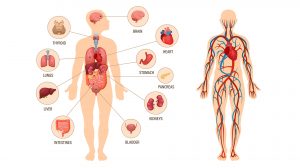Table of Contents
Definition
noun
plural: cyclic adenosine monophosphates
(biochemistry) A cyclic form of adenosine monophosphate that serves as a second messenger for signal transduction at the cellular level
Details
Overview
Cyclic adenosine monophosphate (cAMP) is a form of adenosine monophosphate (AMP). AMP is a nucleotide composed of adenine, ribose and a phosphate group. It is an ester of phosphoric acid and the nucleoside adenosine. AMP is one of the nucleotides that when phosphorylated into adenosine triphosphate (ATP) may serve as a constituent of a nucleic acid (particularly, RNA). ATP forms a chain with other monomeric nucleotides. However, cAMP does not form a chain. Rather, it occurs as a cyclic structure, particularly a 3′-5′-cyclic ester of AMP.
Characteristics
Adenosine monophosphate (AMP) is a nucleoside monophosphate in being comprised of a ribonucleoside and one phosphate group. It means it has a ribose as its sugar and one phosphate group attached. Its nucleoside contains a purine base, i.e. an adenine attached to the ribose sugar. It has only one phosphate group attached to the nucleoside.
Adenylic acid
cAMP is also referred to as adenylic acid. It forms as a condensation product of adenosine and phosphoric acid. It is a nucleotide found among the hydrolysis products of all nucleic acids. 3′-adenylic acid (adenosine 3′-monophosphate) and 5′-adenylic acid (adenosine 5′-monophosphate) differ in the place of attachment of the phosphoric acid to the d-ribose. Deoxyadenylic acid differs in having H instead of OH at the 2′ position of d-ribose.
Common biological reactions
Common biological reactions
cAMP is produced from ATP. The process is catalyzed by adenylate cyclase that is located at the cell membrane. The enzyme is activated in turn by signaling molecules that bind to adenylate cyclase stimulatory G-protein-coupled receptors. In terms of catabolism, cAMP is degraded by converting it into AMP by the enzyme phosphodiesterase”.
Biological functions
cAMP serves as a second messenger for signal transduction at the cellular level. It is used for intracellular signal transduction in many different organisms, conveying the cAMP-dependent pathway. In particular, it is used in transferring into cells the effects of glucagon and adrenaline. These hormones cannot pass through the plasma membrane of target cells and therefore need cAMP as a second messenger. It works by activating protein kinase A (PKA). cAMP binds at the regulatory sub-units of the protein kinase, which leads to the dissociation of the latter into regulatory and catalytic sub-units. The catalytic sub-unit may act on certain protein substrates, transferring phosphate to the latters’ serine or threonine residues. Upon phosphorylation, the protein substrates may act on the ion channels or they may become inhibited. Activated PKA may also act on (i.e. phosphorylate) specific proteins bound to the promoter regions of DNA, and thereby further enhance transcription. Not all protein kinases though respond to cAMP. For instance, protein kinase C is not cAMP-dependent. 1
Apart from the intracellular signal transduction with certain kinases, cAMP has also a role in the regulation of the passage of calcium ions through ion channels. Its activation of calcium channels gives rise to a minor pathway through which growth hormone-releasing hormone facilitates the release of growth hormones.
In bacteria, cAMP is involved in the positive regulation of bacterial lac operon in association with the culture medium used for bacterial growth.1 It also serves as an extracellular morphogen for some slime moulds.
Supplementary
Abbreviation(s)
- cAMP
- cyclic AMP
Chemical formula
Synonyms
- 3′,5′-cyclic adenosine monophosphate
- cyclic adenylic acid
- cyclic phosphate
Further reading
See also
Reference
- “Cyclic adenosine monophosphate”. Retrieved from ://en.wikipedia.org/wiki/Cyclic-adenosine-monophosphate Link.
© Biology Online. Content provided and moderated by Biology Online Editors







